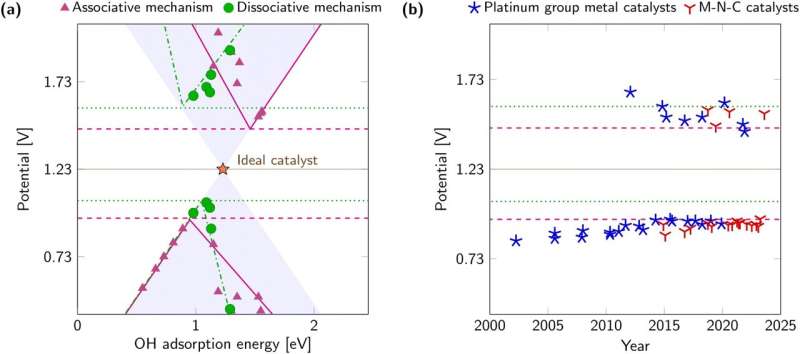This article has been reviewed according to Science X's editorial process and policies. Editors have highlighted the following attributes while ensuring the content's credibility:
fact-checked
proofread
Geometry-adaptive electrocatalysis: Proposed approach could double efficiency of energy conversion technologies

As the world seeks sustainable solutions to meet escalating energy demands, a collaborative team of researchers from the Universities of Tartu and Copenhagen has proposed an innovative approach to overcome long-standing limitations in oxygen electrocatalysis.
Oxygen electrocatalysis involves reactions, such as oxygen evolution and reduction reaction, which are crucial in various electrochemical energy conversion and storage systems like water splitting, fuel cells, and metal-air batteries. These reactions involve breaking and forming multiple chemical bonds, which typically have high activation energies.
This makes it difficult to find catalysts that can effectively lower these energy barriers and facilitate the reactions. To overcome these limitations and accelerate the transition to a hydrogen economy, a novel paradigm for catalyst design is required. Despite theoretical constraints, the research team has discovered a practical method to surpass the limitations.
In a recent article published in ACS Catalysis Science and Technology, the research team introduces an innovative concept of geometry-adaptive electrocatalysis. This approach utilizes catalysts that dynamically adjust their geometry during a reaction, bypassing the theoretical limitations that have hindered progress in oxygen electrocatalysis for decades.
"This concept has the potential to revolutionize the field of oxygen electrocatalysis," says Ritums Cepitis, the principal author of the study, a 4th year Ph.D. student at KongiLab at the Institute of Chemistry. "Our model demonstrates that ideal catalysis is within reach, and in practical terms, it could potentially double the efficiency of energy conversion and storage technologies," adds Dr. V. Ivaništšev, who developed the idea with Prof. J. Rossmeisl during a fellowship at the University of Copenhagen.
"Now, our group is ready to put this approach into action. The laboratory work will demand even greater creativity than the modeling phase, but we already see promising advancements," says Associate Professor Nadežda Kongi, the leader of the Inorganic Functional Materials research group (KongiLab) at the University of Tartu.
More information: Ritums Cepitis et al, Bypassing the scaling relations in oxygen electrocatalysis with geometry-adaptive catalysts, Catalysis Science & Technology (2024). DOI: 10.1039/D4CY00036F
Provided by Estonian Research Council





















